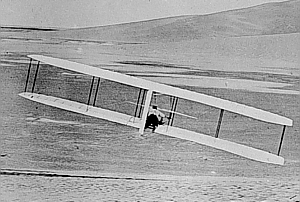
1902 Model B glider
used as the basis for the Wright's patent applications
|
Prev Page |
Next Page |
Our tables of air pressures and our experience in flying with the 1902 glider enabled us, we thought, to calculate exactly the thrust necessary to sustain the machine in flight. But to design a propeller that would give this thrust with the power we had a t our command, was a matter we had not as yet seriously considered. No data on air propellers was available, but we had always understood that it was not a difficult matter to secure an efficiency of 50% with marine propellers. All that would be necessar y would be to learn the theory of the operation of marine propellers from books on marine engineer ing, and then substitute air pressures for water pressures. Accordingly we secured several such books from the Dayton Public Library. Much to our surprise, all the formulae on propellers contained in these books were of an empirical nature. There was no way of adapting them to calculations of aerial propellers. As we could afford neither the time nor expense of a long series of experiments to find by trial a propeller suitable for our machine, we decided to rely more on theory than was the practice with marine engineers.
It was apparent that a propeller was simply an aeroplane travelling in a spiral course. As we could calculate the effect of an aeroplane travelling in a straight course, why should we not be able to calculate the effect of one travelling in a spiral cours e? At first glance this does not appear difficult but on further consideration it is hard to find even a point from which to make a start; for nothing about a propeller, or the medium in which it acts, stands still for a moment. The thrust depends upon. t he speed and the~ angle at which the blade strikes the air; the angle at which the blade strikes the air depends upon the speed at which the propeller is turning, the speed the machine is travelling forward and the speed at which the air is slipping backw ard the slip of the air backwards depends upon the thrust exerted by the propeller, and the amount of air acted upon. When any one of these changes, it changes all the rest, as they are all interdependent upon one another. But these are only a few of the many factors that must be considered and determined in calculating and designing propellers. Our minds became so obsessed with it that we could do little other work. We engaged in innumerable discussions, and often after an hour or so of heated argument- , we would discover that we were as far from agreement as when we started, but that both had changed to the other's original position in the discussion. After a couple of months of this study and discussion, we were able to follow the various reactions in their intricate relations long enough to begin to understand them. We realized that the thrust generated by a propeller when standing stationary was no indication of the thrust when in motion. The only way to really test the efficiency of propeller would be to actually try it on the machine.
For two reasons we decided to use two propellers. In the first place we could, by the use of two propellers, secure a reaction against a greater quantity of air, and at the same time use a larger pitch angle than was possible with one propeller; and in the second place by having the propellers turn in opposite direction, the gyroscopic action of one would neutralize that of the other. The method we adopted of driving the propellers in opposite directions by means of chains is now too well known to need description here. We decided to place the motor to one side of the man, so that in case of a plunge head first, the motor could not fall upon him. In our gliding experiments we had had a number of experiences in which we had landed upon one wing, but the crushing of the wing had absorbed the shock, so that we were not uneasy about the motor in case of a landing of that kind. To provide against the machine rolling over forward in landing, we designed skids like sled runners, extending out in front of the main surfaces. Otherwise the general construction and operation of the machine was to be similar to that of the 1902 glider.

|
Prev Page |
Next Page |